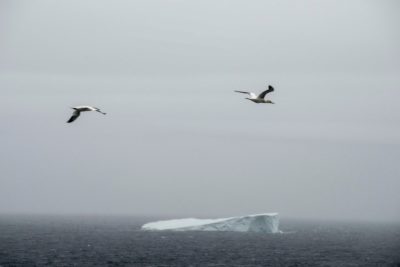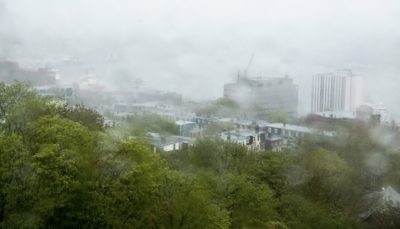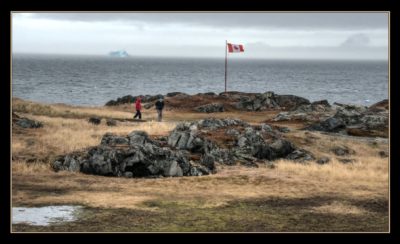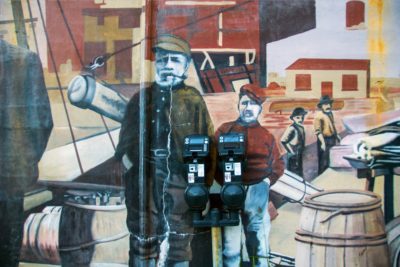by Bill Murray
With earth set on a slow rolling boil through the rest of the summer, now might be a good time to mentally transport oneself to the cold. How’s about a winter weather sailor’s tale?
St. John’s, Newfoundland and the Grand Banks

People feel pain but too often fail to appreciate its absence. There are solid, evolutionary, survival-dependent reasons to prioritize pain – flee that sabre-toothed tiger, and fast! – but how much fuller life would be if we could celebrate time spent pain free. And what do you know, here is an island full of people who do just that. Welcome to “The Rock.”
Newfoundland marches to the beat of its own drummer, or at least to the ticking of its own clock. An hour and a half ahead of the U.S. east coast, the island they call “The Rock” is an island alone. No one shares Newfoundland Standard Time, which is a half hour ahead of the rest of Atlantic Canada and a half hour behind the nearby French territory of Saint-Pierre et Miquelon.
At 400,000 square kilometers, Newfoundland and Labrador comprise a province triple the size of the other Canadian maritime provinces of Nova Scotia, New Brunswick and Prince Edward Island combined. Newfoundland is the sixteenth largest island in the world, larger than Iceland, or Cuba.
In its far eastern perch, St. John’s is a hybrid of the working towns of Greenland that put their industrial sides forward and the larger coastal towns farther south in Nova Scotia and New England.
The St. John’s working harbor dominates a tiny sheltered bay along Water Street, the oldest commercial street in North America, dating to the early 1500s. Two important streets parallel Water Street away from shore, Duckworth Street and Queen’s Road, and that, really, is St. John’s.
Duckworth Street domineers over commerce with Water Street nearly at water level, a harder, grittier block toward the water. The Toronto Dominion bank dominates the skyline the way banks do.

The climate is not the best. After one seductive afternoon of sun, we will never see as far as 500 meters again; the tamped down hues of fog and rain set in with determination. Signs on the buildings caution “beware of falling snow and ice,” a hint at the real weather around here.
The bane of the Avalon peninsula is the wind. When not from the southwest via the jet stream, it sweeps down as an express from Greenland. Unlike Iceland and even Svalbard, which are touched by the Gulf Stream, Newfoundland’s coast is subject to the Labrador current from the north. St. John’s finds itself in the path of errant icebergs while south of the latitude of Paris. Even with the air temperature in the 40s the wind will slice you up.
And still you can’t help but like St. John’s the minute you drive in. A hippie town. Piercings and peasant dresses, muscle cars and used bookshops. A kind of north/south bookend to Key West.
In Key West it’s the occasional hurricane. Here maybe five times a year the city just shuts down completely in snow. The rest of the city behind Duckworth Street rises sharply onto a hill and when it’s slick enough everything not secured slides straight down, so when a storm comes everybody just stays home.
This is the grim physical expression of Newfoundland that flies in the face of all these winning smiles: Limits. Northern constraints. St. John’s is no brash, can-do American town.
Port cities’ wide harbors invite in guests, their front doors flung open to the world. But access to St. John’s is boa-constricted, the sea visible only for a scant thousand feet through the Narrows, just a notch between the dramatic not-quite-mountain called Signal Hill after Marconi and the opposite perch of Fort Amherst.
On the inland side of the Narrows, ships are marvelously protected; the hills on either side of the notch run effective interference, sparing St. John’s waterfront the fury of the sea.
That is good because St. John’s, and Newfoundland and Labrador more generally, have had their share of superlative calamities. It seems like in Canada, the farther east you go, the greater the tales of woe, and Newfoundland is as far as you can go.
In Canada’s deadliest natural disaster, a water borne fury spread without warning across Newfoundland in September 1775. The squid catch was late that summer, so untold numbers of fishing boats were at sea when hurricane waters rose twenty feet higher than normal in Conception Bay, killing 300 men at a stroke. Tales are told that the sole survivor at sea was a boy who sailors tied to a ship’s mast. Total casualties numbered over 4,000.
In 1846, a fire in a cabinetmaker’s workshop fed on closely built wooden buildings, consuming 2,000. Another in 1892, this one they call The Great Fire, left 13,000 homeless.
The 1929 Grand Banks earthquake caused Canada’s largest submarine landslide, snapping twelve trans-Atlantic underwater cables, and kicked up a tsunami that killed 28 along Newfoundland’s coast.
Maritime Canada’s meanest tragedy tore St. John’s families apart; just outside this hotel window on Water Street, the human aspect of a terrible tragedy played out as families thronged the telegraph office, demanding news of their men caught on the ice outside the Narrows.
A century ago St. John’s was a vital, bustling hub of maritime commerce, Water Street its beating heart. As the closest North American landfall to Europe, a concentration of trans-Atlantic communication cables came ashore here. St. John’s anchored the most bountiful cod fishing grounds in the world. But the sea provided bounty far beyond fish.

In late summer ice forms between Canada and Greenland in Baffin Bay, far to the north of the sealing grounds. The Labrador current moves the young ice south and with the coming of winter it grows into ten-foot blocks the aquamarine color of sea water, save for edges made white and jagged by constant grinding against other ice.
Off the Labrador coast, most of the way to Newfoundland, the ice freezes into vast, miles-long sheets that jostle, crack and re-form, and arrive off Newfoundland covered with gravel from scrapes against land. The job of the swiler, as seal hunters were called, was to walk across this ice field for miles, searching for seals.
Harp seals follow an ancient migratory cycle between the Arctic and the Grand Banks, a shallow part of the continental shelf off Newfoundland. In early March harp seal mothers climb onto the ice pans, give birth to their pups and abandon them, so that each year hundreds of thousands of newborn seals would lay helpless when the swilers approached.
The swiling ships sailed north into the ice field each March. It was St. John’s biggest event of the year. Swiling became a sort of national sport, with statistics compiled like the number of pelts taken in a season and the career lifetime hauls of “jowlers’,” or successful swiling captains.
No other country’s commercial fleets systematically sailed into ice floes. No other country even had a dedicated sealing fleet. Successful St. John’s captains became swashbuckling national heroes, in demand as pilots for polar excursions.
•••••
Twenty-nine- year-old Wes Kean sailed as Captain of one of the smaller ships in the fleet, the SS Newfoundland. Wes’s father, a former cabinet minister and Tory government representative named Abram Kean, sailed in command of the Stephano, the most powerful ship in the swiling fleet. Some called the Stephano the finest ice-breaker in the world.
At 59, Old Man Kean was a sealing legend, prohibition advocate and a strict Methodist. A sailing superstition discouraged launching a mission on a Friday. Abe Kean always launched on Friday. The kind of man he was.
There had been talk of a disastrous season. The ice was too tight for the ships to work, people said. Wes had no time for such talk, only a reputation to make. To become a big league “jowler,” he had to get out on that ice.
On 30 March, 1914 Captain Abram Kean found seals and signaled to Wes by raising his ship’s aft derrick (a wooden crane). Wes saw the signal but his Newfoundland was already jammed into ice a half dozen miles away. His ship’s lack of a steel hull prevented him from breaking through in the direction of his father and the seals.
Wes Kean sent his men on foot across the ice toward his father’s ship. He expected his men would spend that night aboard the Stephano after a day of hard swiling. Trouble was, a mighty storm was coming.
A total of 166 men set out that morning from Wes Kean’s ship but sensing the storm, 34 turned back, to catcalls and shouts of “cowards!” A fair number of those who turned back were elders who knew more weather lore than the boys, aphorisms like “If the wind come from the east, ‘tis good for neither man nor beast.”.
The 132 of Wes Kean’s swilers who didn’t turn back spent two nights stranded in a blizzard on the ice. Seventy-seven didn’t come back alive. After a four-hour hike across tough ice the sailors reached and boarded the Stephano in late morning, weather coming on fast. Captain Abe searched the skies, fortified the Newfoundland’s sailors with hard tack and tea, and turned them back out on the ice in under an hour.
Early in any year’s harvest, blood and grease would cover the rough planking laid down on the ships’ decks as protection against the sailors’ hob-nailed boots. Before long even new swilers “learned to eat the warm, fresh hearts cut still beating from seal carcasses.” But so far this year, for more than a week now, it was only hard tack and tea.
Old Man Kean’s orders might as well have been the Firm Law of God, not only on his ship but across the whole fleet. When he turned Wes’s men back onto the ice the Old Man told the sailors to walk back to their own ship, harvesting a field of pelts the Stephano had left earlier. Abram Kean foresaw no problems.
Grumbling broke out, but the Old Man convinced George Tuff, the leader of the men on the ice, that he and his men had an easy walk to back to his son’s ship, considered them safe and put them out of his mind.
“They’ll be ahl rate,” he thought.
Wes grew uneasy with the worsening of the storm, in the absence of his crew.

St. John’s was (still is) compact, with most commerce conducted on foot, but early on that day Water Street emptied out as snow, Cassie Brown writes, “… was beginning to choke the streets … Business came to a halt. Streetcars tried to plow through snowdrifts, bogged down, and could not be moved. People deserted the shops and the streets and let winter have full sway.” Clear across The Rock the fear of wives and mothers curdled into fright and rose with the howl of the wind.
Wes Kean and the Old Man each assumed the other had Tuff and his men. Wes was sure his father had kept them aboard the Stephano and Abe assumed they followed his orders to return to Wes and the Newfoundland. Neither sent out a search party. Neither sounded their whistles so that as the blizzard closed in the men on the ice could hear in what direction to walk.
The sealers were a hundred miles north of St. John’s when the first flakes fell. Wes Kean’s brother (and the Old Man’s eldest son) Joe commanded another swiling vessel, the Florizel. He sounded his ships’s whistle to summon his men back from the ice. Tuff’s men, the Newfoundland’s men, would spend the next two nights on the ice.
Finally becoming blinded by blowing snow, the men raced through snowdrifts and over the ice, struggling in ever more desperate search of the Newfoundland. At dark they built what shelter they could from loose ice. They split into three watches and each built windbreaks from the ice, against which they would spend the first night, but the progress of the storm moved winds from the east around to the north, rendering only the best built windbreak effective by morning.
•••••
With morning’s light the men who could tried to walk on, hearts pounding just to stay alive. Consumed by violent, shivering convulsions, they searched each others’ eyes and found only stark, open terror. Their predicament, they were sure, meant that they were doomed.
Some died frozen in a posture of prayer. Stephen Donovan died on his feet and froze standing. One father and son were found frozen in an embrace, a pose captured in a memorial statue. Each man died in his own intimate way, stilled by the ice.
In the morning Wes Kean spotted what was left of his men through his spy-glass. He signaled other ships. The SS Bellaventure, his brother’s ship the Florizel and Captain Abe’s Stephano responded as best they could. Of the 77 who died, 69 bodies were found.
As news of the disaster spread family members besieged the telegraph office, gathering with the dread of knowing there must be few survivors. Crowds grew until Water Street was impassable.
Funeral parlors ran out of caskets. In the basement of the Seamen’s Academy, doctors thawed bodies and pulled those frozen together apart.
All of Newfoundland wept. Some of the men’s bodies rode home in trains they could never afford in life.
At the inquiry neither Kean was found guilty of anything more serious than “errors of judgement.” Ships were henceforth required to carry additional safety equipment and from now on, a wireless.
Abe Kean hunted seals for twenty more years. In 1934 he brought back what they reckoned was his millionth pelt, for which he was awarded the Order of the British Empire for being the most lethal killer of seals in history.
•••••
Two books in particular informed my writing about the whaling disaster. I recommend Jenny Higgins’s Perished: The 1914 Newfoundland Seal Hunt Disaster and Death on the Ice: The Great Newfoundland Sealing Disaster of 1914, by Cassie Brown.
I write things like this twice a week at Common Sense and Whiskey. Please join me there.
•••••
